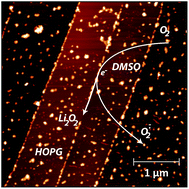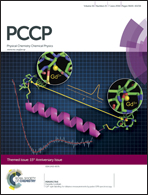AFM study of oxygen reduction products on HOPG in the LiPF6–DMSO electrolyte†
Abstract
Ex situ atomic force microscopy (AFM) has been used to study the morphology of oxygen reduction products in the LiPF6–dimethyl sulfoxide (DMSO) electrolyte, i.e. Li2O2 on a highly oriented pyrolytic graphite (HOPG) surface. Both cyclic voltammetry and chronoamperometry have shown that at low cathodic polarization the initial deposits decorate the edge steps of HOPG. At higher overpotentials a massive deposit covers the terraces. Upon charging the battery cathode Li2O2 oxidation and dissolution do not take place until high overpotentials are reached at which solvent decomposition has been demonstrated by in situ FTIR studies.

- This article is part of the themed collection: PCCP’s 15th anniversary

 Please wait while we load your content...
Please wait while we load your content...